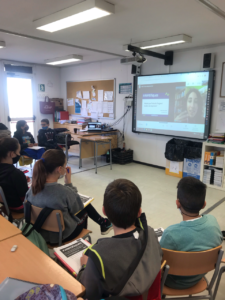Last 11 of February we celebrated worldwide the 6th International Day of Women and Girls in Science, with plenty of activities to help eliminating long-standing biases and gender stereotypes that are steering girls and women away from science related fields.
One of these science disseminations activities was held by Núria Torras, researcher working at Brighter Project in the Biomimetic systems for cell engineering group from Elena Martinez at IBEC, Barcelona. She participated in the annual event 100tifiques, organized by the Catalan Foundation for Research and Innovation (FCRI) and the Barcelona Institute of Science and Technology (BIST), an initiative that aims to bring science closer to schools and claim the female scientific talent.
She gave an online talk entitled “Models to study organs and tissues: lets print them?” to 18 students from the school Alzines Balladores, at Sant Feliu de Buixalleu, a small village near Barcelona, where she explained a little bit the work done in Brighter project. She talked about the principles of 3D printing and the biological models, material and cell types they use in the lab. These students now know that Nuria and her colleagues adapted the 3D printing technique in their lab to develop in vitro models that help researchers understand how our body works!

Students were very interested and motivated and took the opportunity to exchange with Nuria not only about science but also about being a female scientist. These are some of the questions they asked Nuria:
Joana: What inspired you to be a scientist?
Aina: How old was you when you began to make science?
Abril: What do you like the most in your work?
Natasha: How long do you take to develop your models?
Lila: Do you wish that your daughter also became a scientist?
Bruna: Have you ever thought about leaving science?
Aina: Is it difficult to be mom and scientist?
George: You have explained that with 3D printings we can print everything, even meal! How do they do that?
It is worth to remark that from 8 questions, 7 came from girls… This can make us think that actions like this are effective and must be held as much as possible to include girls and women in science!